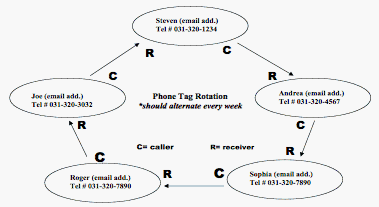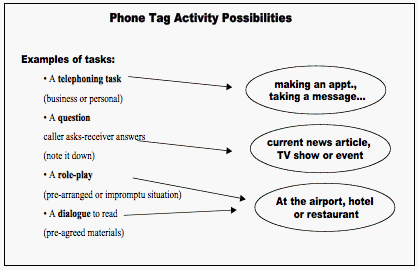Phone Tag - A Practical Activity for Using English
Aaron R. HughesSamsung Globalization Team (Yongin, South Korea)
ahughes_7 [at] yahoo.com
Phone Tag is a group activity in which one student initiates the activity by calling another student with a specific language task. They complete that task, and then that student calls another student until everyone in the group makes and receives one call and has completed the language related task.
The Problem
As many language instructors might fully understand, it is difficult for students to use spoken English when they are living in non-English speaking countries. It is especially difficult for adult language learners that work.My students are trainees. Some are sent abroad to overseas branches yet most stay in country and only use English sparingly after completing our programs.
Therefore the trainees worry that after spending 10 weeks in our program, and truly making substantial progress, that they will return to their homes and workplaces and their English will lie dormant and slowly digress. This is why many of my language learners have asked me: how can I keep my English when I rarely have a chance to use it?
A Solution: Phone Tag Activity
After considering this situation for some time, I came up with a simple solution. I adapted a basic child's game, tag, into a student-centered communicative activity that has built-in flexibility to allow business people to engage in a practical ESL activity.Phone Tag is a group activity in which one student initiates the activity by calling another student with a specific language task. They complete that task, and then that student calls another student until everyone in the group makes and receives one call and has completed the language related task.
Phone Tag is very similar to a normal telephone call except that the purpose of these calls is a tangible ESL task. From my experience, this activity works very well with Business English classes; however, I feel it can be adapted to meet many general purposes too. Also, I have been using Phone Tag mostly as a continuing study activity, but it can have application during a course as well.
The reason I use this activity after the course is that the classes have momentum after studying together and secondly, the trainees have learned a lot about their fellow classmates and have developed friendships, as well as, small English learners' networks. Thus, the students have an intrinsic motivation to both stay in touch with their classmates and continue practicing their English communication skills.
Requirements
- A phone
- An e-mail address
- A small network of English speakers, 3-5 native or non-native members
- A little time (ten minutes per week)
- And some motivation to practice English
How It Works
A Phone Tag Activity Has Three Main Parts.
Like all proper telephone calls it should have a greeting (a short self-introduction and possibly some small talk), followed by a purpose (in this case a task for practicing English, e.g. making an appointment, booking a hotel, renting a car, etc.), and finally a farewell (short expression to conclude the call). See the example below.
A few basic parameters are necessary. First, it is important to set objectives. For my business language learners to become more comfortable speaking English over the telephone, I suggest they complete one task per week in order to make a habit out of it. Secondly, I recommend that one whole phone call only take 5 minutes because they are all working adults and the activity should not be too time consuming.
Language Functions Like Confirmation and Clarification Strategies Are Practiced.

A Phone Tag Activity Needs a Format for Making and Receiving Calls.
This takes some managing; however, if the groups are kept small enough, the management will not be too complicated. I recommend that one member of the group be responsible for setting the weekly calling order and emailing the order to everyone. I would also suggest that each caller email the person they are expected to call and ask them when is a good time to call (a short e-mail with the subject: requesting call time). Afterwards, when the first caller receives a call then he knows the Phone Tag chain was not broken and he sends out an e-mail to congratulate the group for completing the task. See the model below.
There are Many Possible Phone Tag tasks.
Of course it certainly depends on the proficiency level of the group and on the group's wants and needs. However, an intermediate-level group might be able to handle questions that elicit opinions; whereas, a lower level group may falter on such a task. Therefore in deciding on appropriate level tasks, it will be important to have some teacher guidance. Here are some tasks that have worked well for my trainees, whom mostly ranged from low intermediate to high intermediate learners. Sometimes a little preparation is necessary on the part of each group member, such as: watching the news or reading an article, and other times groups choose to use (review) specific textbooks. See some examples below.
Summary
Phone Tag is suitable for various proficiency levels and can be adapted in many ways whether to support specific lessons during a course or to encourage follow-up practice in a fun and engaging way. In addition, particular language functions like confirmation and clarification strategies receive a lot of practice and reinforcement.For my Business English classes, it has helped to foster small language learner networks, which have become forums for my English language learners to both stay in touch with each other and practice language tasks in realistic contexts. I hope this activity can be useful for your classes as well.
The Internet TESL Journal, Vol. XII, No. 3, March 2006
http://iteslj.org/
http://iteslj.org/Techniques/Hughes-PhoneTag